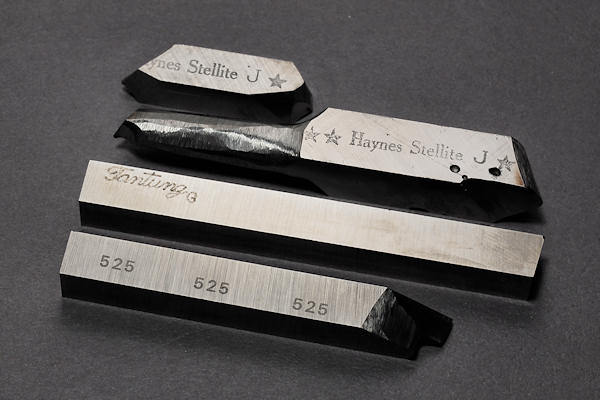
With the refinement of carbide insert cutting tools, many believe cast alloy tools have been rendered obsolete in commercial machining. That's certainly true for run-of-the-mill CNC work in aluminum and free machining steels, however some applications remain where cast alloy tools should be considered.
These alloys possess properties somewhere between high speed steel (HSS) and carbide. They can be ground with a standard grinding wheel, though the process can be a bit slow going. They're tough and work well on interrupted cuts and on castings that would tend to chip carbide, though they're more prone to chipping than HSS. High lubricity is another feature and that prevents welding of material on the tool tip. They cannot be annealed and thus retain their hardness and cutting ability to red heat. In general, they will operate at 2X or more the speed of HSS, but not that of carbide.
For home machinists cast alloys are an excellent choice for less rigid and lower speed/power machines that can't take maximum advantage of carbide. They lend themselves to off hand grinding better than carbide. The biggest obstacle for the home machinist is getting tool blanks at a reasonable cost.
You may find the occasional cast alloy tool in used and surplus tooling. The alloys are completely non-magnetic so you should always carry a magnet when inspecting odd lots of tooling. The etched names will often be ground away and the magnet will quickly separate HSS from cast alloy tooling. In general you are looking for the following:
Modern cast alloy tools will be ground on all sides and look similar to HSS tooling. They resist corrosion extremely well and may stand out in used tooling for that reason. On the other hand, don't be put off by the appearance of older cast alloy tooling. Some of it may look like it was cast in a backyard barbecue grill. It will be dark in color and have significant imperfections and poor grinding. Others will have passed it by, but their loss is your gain. New cast alloy blanks are still available from at least three manufacturers but don't expect to get them for import or flea market HSS prices!
The internal structure of old cast alloy tool blanks was said to be non-uniform due to the casting process. The instructions were to keep the cutting edge as close to the chilled surface as possible, and the blanks were marked in various ways to identify the surfaces. There is some contradictory information floating about concerning this, but I believe Stellite blanks were labeled on the bottom and the cutting edge should be opposite the etched label. Very old blanks had a notch ground on the bottom of the far end. Some say the top. The cutting edge should be ground on the top surface of the other end. If the notch is ground away, another one should be made. The end angles on the blank are another clue. I've seen Tantung blanks with the notch on the top, at least based on the angle at the other end. Sometimes you'll find old tools where there's no more printing and the notch is long gone. In that case you have to hope the previous user kept the correct surface facing up. In recent communications with AGI-VR-Wesson they said grinding orientation is not important with new Tantung G tool blanks. I'd like to find some original manufacturers literature to clear up the matter and until I do my confidence in any of this is minimal. For what it's worth, I did some tests on one of my blanks, torturing a cutting edge on both sides. This suggested the notch marked the bottom, as the opposite face seemed a bit less apt to chip, but the difference wasn't great.
I made hardness measurements on all the faces of several different blanks in my collection. All the faces of all the tools, regardless of manufacture, were about 63 on the Rockwell C scale. From that I have to conclude that it's not extremely critical which face you grind. Certainly when hardfacing is done by melting the material with an O-A torch onto the surface of something else, there's little control or concern about the matter.
Let's look at some photos of various second hand tools and blanks I've acquired in used tool shops and at flea markets. The first shows typical markings for Blackalloy 525, Tantung G and Stellite J.

This is my favorite threading tool using the Blackalloy 525 blank.
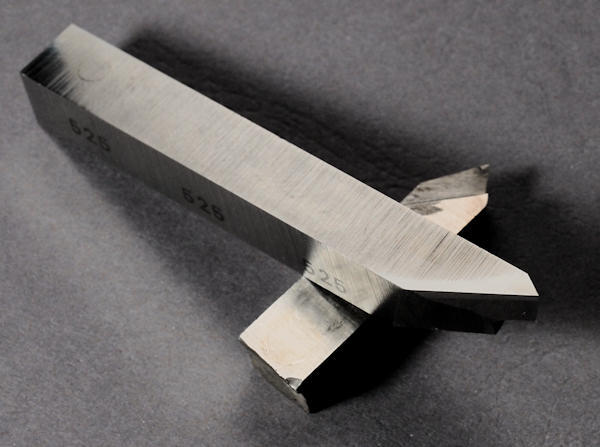
Here are three unmarked blanks I found in a used tool shop for 30¢ apiece. They have the typical notches but I don't know for sure which is top and bottom.
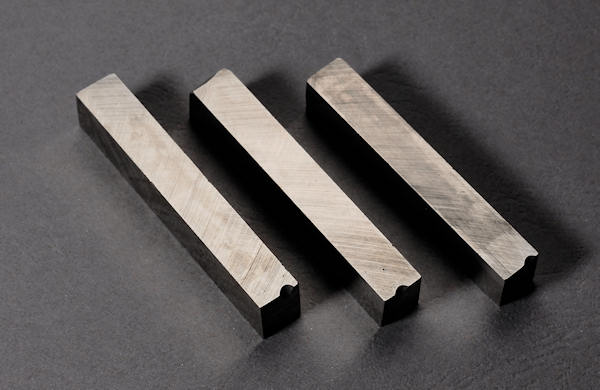
Older tools can look pretty bad, with rough grinding and a lot of imperfections, but the alloy is still good and you shouldn't shy away from them if the price is right.
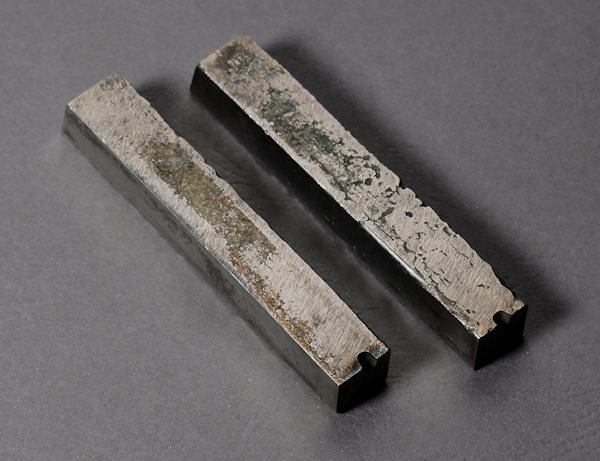
This is my entire collection of cast alloy tools, acquired over a couple years at flea markets and used tool shops. I'm not responsible for the grinding and geometry of anything but the threading tool, though I'm sure they all served some noble purpose back when cast alloys were more popular.
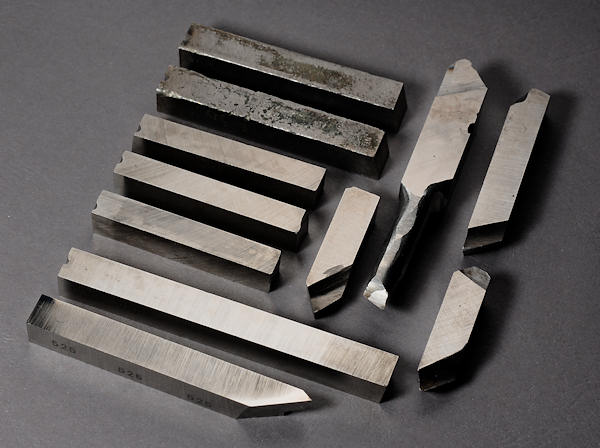
The most important rule for cast alloys is never to quench them after grinding. The manufacturers are universal in this caution. Let them cool slowly, as needed, while grinding. You can use continuous coolant flow, or none at all, but never quench or dribble. The alloys must not be subjected to thermal shock. This is also true for HSS to retain its full performance, but ignoring the caution will have much less serious consequences with HSS than for these high performance cast alloys.
The preferred angles are a bit different than HSS as more support is needed to prevent chipping of the edge. An old Southbend tool grinding note says to use the steepest angles that still allow the tool to cut freely. The Blackalloy Company has a good chart of specific lathe tool angles on their site. I like them a lot but a 3/8" square Blackalloy 525 lathe blank will set you back just under $35.
From the Deloro Stellite site the composition of Stellite Star J is:
| Co | Ni | Fe | C | Cr | Mn | Si | W |
|---|---|---|---|---|---|---|---|
| Bal | 3 | 3 | 2.5 | 32 | 1 | 0.5 | 17 |
Tantung tools are available from AGI-VR Wesson. The Tantung G tool blanks seem to have the most reasonable pricing as a 3/8" x 2.5" lathe blank is about $20 as of this writing. More information on Crobalt is available from Crobalt. I haven't done any type of comparison between the different brands so can't comment on any relative merits, but they are all of very high quality.
Wear a dust mask when grinding any of these alloys as they have a high percentage of cobalt, which is toxic. Do not breath the dust! That's probably good advice when grinding high cobalt types of HSS tools as well.
C. Hoffman
September 19, 2010